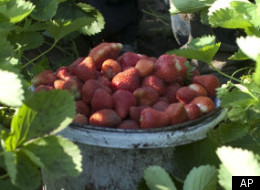
It is a veritable maxim of the modern environmental movement: To help heal the planet, eat local.
If only it were that simple.
A growing number of studies, including one recently published in the journal Environmental Science & Technology, suggest that the economic arithmetic underlying our food production and distribution system is profoundly complex, making it increasingly difficult to rely on bumper-sticker solutions.
The most recent analysis, headed up by David Cleveland, a professor of environmental studies at U.C. Santa Barbara, looked at fruit and vegetable production in Santa Barbara County, a bountiful pannier of fruit and vegetable yields. The county is among the nation’s top one percent in terms of agricultural value overall.
And Santa Barbara, with its farmers markets, organic farming, burgeoning networks of Community Supported Agriculture, and other deep-green bona fides, would seem a ripe locale for the food localization movement.
But Professor Cleveland and his co-authors, most of them former undergraduate students in theEnvironmental Studies Program, found more than 99 percent of the produce produced in Santa Barbara County is, in fact, exported, and roughly 95 percent of the produce consumed in the county is imported from elsewhere.
Some of the food is shipped in from from far-flung spots in Chile and Argentina. The most remote source? New Zealand.
The researchers also concluded that even if the situation were somehow remedied, and all produce grown in Santa Barbara County remained local (sold and consumed inside the county), the impact on greenhouse gases would be negligible, reducing emissions from the agrifood system by less than one percent overall.
Despite the cache and popularity surrounding the locavore movement, Cleveland argues, transportation really accounts for just a very small part of the agribusiness footprint.
This is not exactly a revolutionary notion. Previous studies have shown that despite widespread attention to the great distances that many agricultural products now travel in a globalized food system, the production phase dominates greenhouse gas emissions.
One recent analysis put transportation at about 11 percent of life-cycle greenhouse gas emissions, with final delivery from producer to retail outlet accounting for just four percent of emissions.
The same study suggested that reducing our consumption of certain food categories wildly high in emissions during their production, particularly red meat, would do far more to help the planet than trying to go local.
“Shifting less than one day per week’s worth of calories from red meat and dairy products to chicken, fish, eggs or a vegetable-based diet,” the authors found, “achieves more [greenhouse gas] reduction than buying all locally sourced food.”
Cleveland believes his analysis suggests precisely what’s wrong with emphasizing “eating local” as some sort of goal or end unto itself.
“The takeaway here is that if you just focus on localization — well, food miles have a lot of cache, locavores and all that,” Cleveland told The Huffington Post. “But if you allow that that to become your strategy or the goal for your food system, you can get deceived and not really improve anything.”
Better to choose other goals, Cleveland said, like better community nutrition, for which local agriculture is a necessary but not sufficient component.
Indeed, the researchers noted that while the potential for locally grown produce to improve community nutrition is substantial, particularly among low-income families, simply substituting locally grown fruits and vegetables for imported fare “will not automatically have a positive effect.”
“[T]here are many intervening cultural, social, economic, and geographic obstacles, including national agrifood policy,” the authors wrote in the study. For localization to improve nutrition across an entire community, “a number of other changes would be needed to overcome these obstacles.”
Labor creates another issue. “Harvesting strawberries — a lot of it is done by migrants, and those migrants come from somewhere, they don’t just magically appear,” Cleveland said.
“Communities in southern Mexico are being destroyed by economic policies in this country that drive people to work in American farm communities even as we localize our food system. We want a just food system, but not at the expense of families and communities elsewhere.”
These are the sorts of targets and issues that food activists ought to be keeping in mind, Cleveland said.
“Do localization,” he said, “but don’t get lulled into thinking that it’s the end game.”



